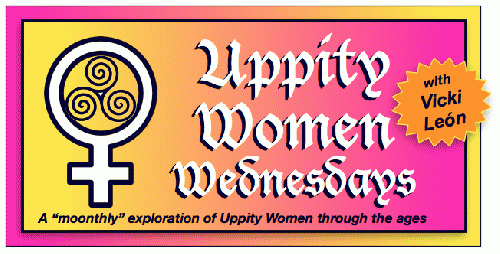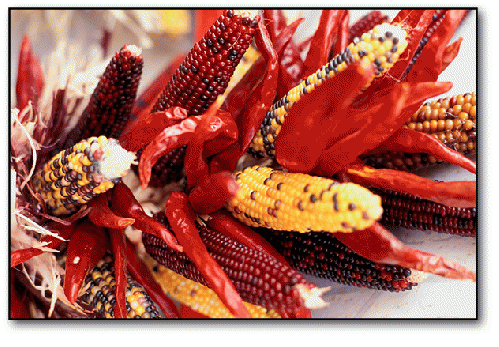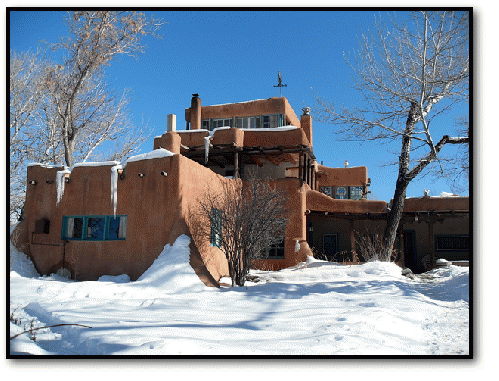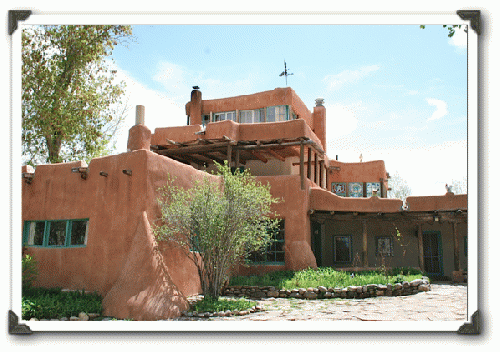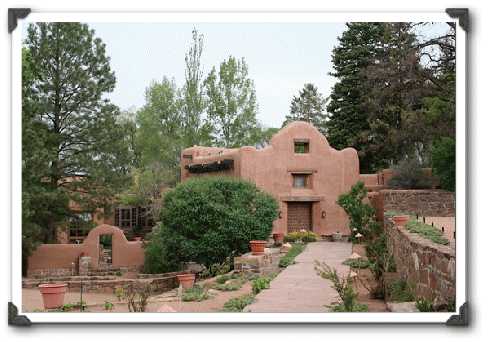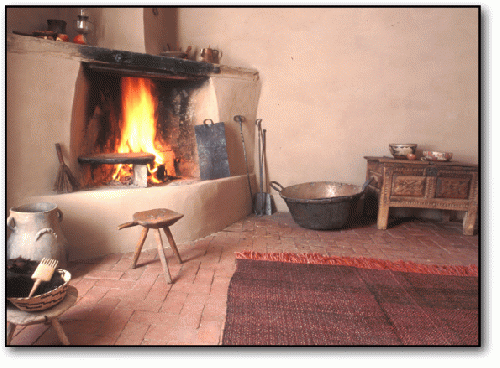To bring in the new year with some sass, Vicki Leon and her writing partner, Joyce Wyels, present a colorful lineup of wildly creative women of northern New Mexico in this month's "Uppity Women Wednesdays" installment. From world-famous Georgia O'Keeffe to the talented new generation of Native American female artists, all of them were influenced by the physical and cultural ambiance of Taos pueblo and environs. Wyels, a long-time contributor to Americas magazine and other periodicals, shared honors with Leon for the California state award for best travel writing in 2012.
What is there about northern New Mexico that has drawn artists and writers, including a surprising number of sassy, creative, powerful women, for over a century?
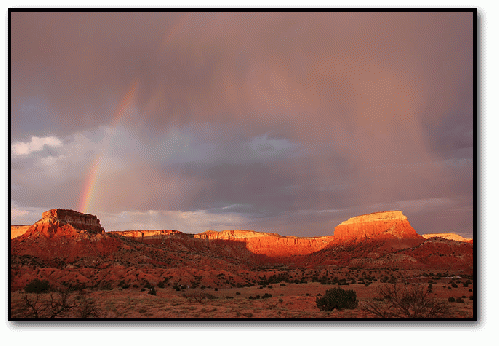
Ghost Ranch with Rainbow
(Image by (From Wikimedia) Larry Lamsa, Author: Larry Lamsa) Details Source DMCA
"The color! The color!" exclaimed Georgia O'Keeffe as she burst on the Southwestern scene in 1929, buoyant from her recent New York successes nurtured by her husband, famed photographer Alfred Stieglitz.
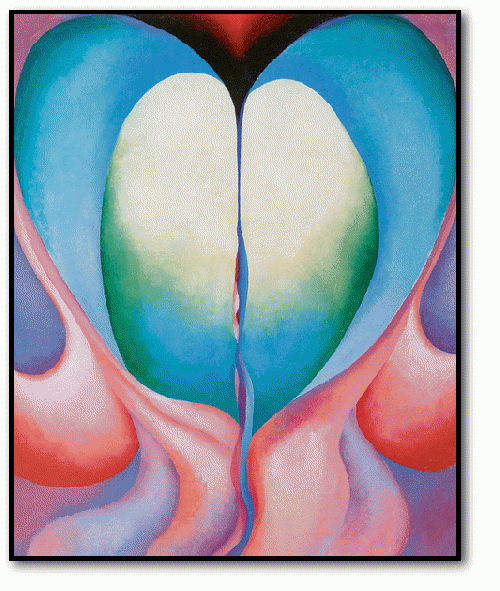
Blue-Pink Series 1 painting
(Image by (From Wikimedia) Georgia O'Keeffe (1887–1986) / https://whitney.org/uploads/image/file/820458/medium_okeeffe_series_ino._8.jpg via https://whitney.org/Exhibitions/GeorgiaOKeeffe; http://doverpublications.com/sampler, Author: See Source) Details Source DMCA
Among the many remarkable women who have found their way to New Mexico, the most celebrated may be O'Keeffe, the formidable painter whose best known works reflect the desert landscapes she observed. As she put it, "When I got to New Mexico I recognized that it was my country. I'd never seen anything like it before, but it fit me exactly. There's something in the air; the sky is different, the wind is different."
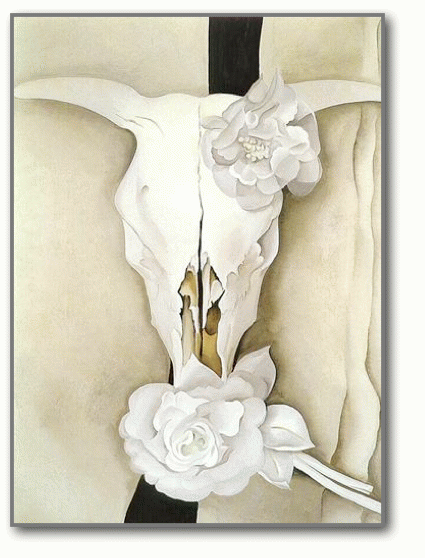
Cow's Skull with Calico Roses, 1931. Col. the Art institute of Chicago.
(Image by Georgia O'Keeffe. Public domain) Details DMCA
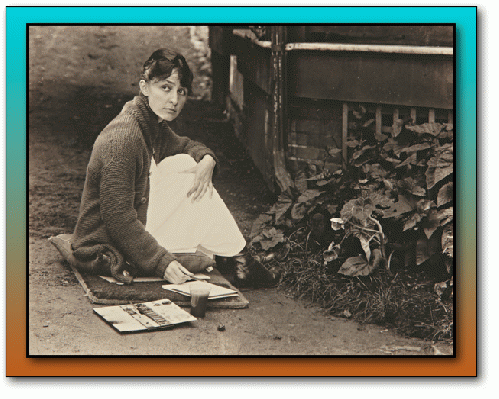
Georgia O'Keeffe in New Mexico, 1918
(Image by (From Wikimedia) Alfred Stieglitz (1864–1946) / Phillips, Author: See Source) Details Source DMCA
O'Keeffe would later pursue her passions at Ghost Ranch near the diminutive village of Abiquiu, which became her favorite artist's retreat. Like many of her contemporaries, first she gravitated to the congenial town of Taos and the welcoming adobe owned by Mabel Dodge Luhan.
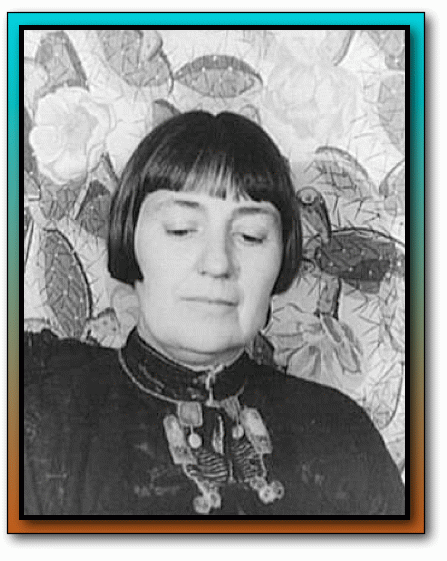
Mabel Dodge Luhan
(Image by (Not Known) Public domain via wiki, Author: Author Not Given) Details Source DMCA
A decade earlier, Luhan had decamped from New York to New Mexico; before that, a freewheeling lifestyle had her alternating between New York and Europe as she embraced, then shed, a succession of husbands and lovers.
While living in Florence, Italy, Mabel Dodge had renovated the elegant fifteenth-century Villa Curonia, first occupied by the Medici family. There she established an avant-garde salon, where the bisexual Mabel enjoyed a brief dalliance with Gertrude Stein. Her invitation to Stein had read, "Please come down here soon--the house is full of pianists, painters, pederasts, prostitutes, and peasants. Great material."
Later, as she presided over her
legendary Greenwich Village salon in New York, Mabel wrote her first published
article, which compared Stein's use of language with Picasso's use of paint. Nevertheless,
it was her journey to New Mexico that heralded a new beginning: "My life broke
in two right then, and I entered into the second half, a new world that
replaced all the ways that I had known with others, more strange and terrible
and sweet than any I had ever been able to imagine."
Mabel found herself drawn to Taos, an artists' colony and venerable village that grew up just a mile from Taos Pueblo, the 1000-year-old multi-level pueblo believed to be one of the oldest continuously inhabited communities in the U.S.
Taos Pueblo also happened to be the ancestral home of her fourth and final husband, Tony Luhan. By degrees, their own four-room adobe expanded into a 22-room estate called "Los Gallos" ("the roosters" in Spanish).
In the 1920s, and for decades thereafter, "Los Gallos" was the undisputed cultural hub of northern New Mexico. Here the Luhans welcomed not only O'Keeffe, but a scintillating group of brilliant minds and creative people that included Aldous Huxley, D. H. Lawrence, Ansel Adams, Martha Graham, Willa Cather, and Carl Jung.
Mabel invited strangers as well as friends to stay at "Los Gallos," especially those writers and artists who might be able to capture the authentic Native American lifestyle of the pueblos as well as the local disdain for crass commercialism. Writing to D.H. Lawrence, she told him that Taos was like "the dawn of the world."
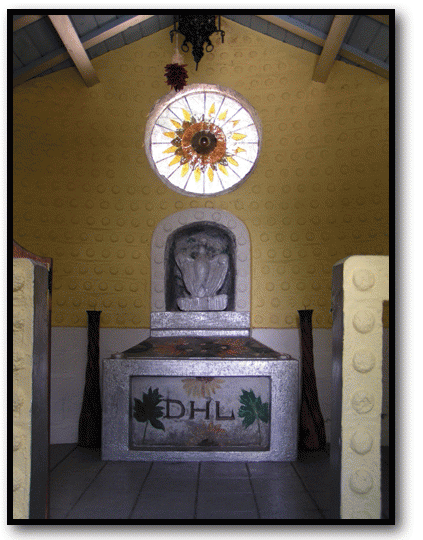
D.H. Lawrence chapel on Kiowa Ranch in Taos
(Image by (From Wikimedia) User:Carptrash, Author: User:Carptrash) Details Source DMCA
D.H. Lawrence first accepted the Luhans' invitation to "Los Gallos" in 1922; in 1924 he showed up with his wife Frieda and the British painter (Lady) Dorothy Brett in tow. Mabel Dodge Luhan provided the trio with a property then known as the Kiowa Ranch. (Today, as part of the University of New Mexico, it's the D. H. Lawrence Ranch.)
Juicy stories continue to be told of Frieda, Dorothy, and Mabel vying for the author's affections--even, it would seem, after his death at age 44, in 1930. The three women tussled over his ashes, which his widow had transported from a cemetery in France. Ultimately, Frieda thwarted her rivals by dumping the ashes into the wet cement that went into the making of his memorial. She's also buried nearby.
During his months in Taos, Lawrence incorporated the Kiowa Ranch into his short novel "St. Mawr" and wrote other works as well. Later he would report, "New Mexico was the greatest experience from the outside world that I ever had. It certainly changed me forever."
Meanwhile, Mabel's writing career began to blossom. During the 1930s she published "Lorenzo in Taos," her portrait of D.H. Lawrence, plus four volumes of her personal memoirs.
Although Mabel Dodge Luhan thought that New Mexico's capital, Santa Fe, was "too civilized," the White sisters--Elizabeth and Martha--found it a perfect amalgam of intellectual heft, artistic talent, and party potential. The Bryn Mawr graduates happened upon Santa Fe (population under 10,000 at that time) on a cross-country trip in 1923, whereupon they alighted for good. The sisters threw madcap parties; they installed the town's first swimming pool; and their masquerade balls were the social event of the season. In some ways, their sprawling estate "El Delirio" (meaning "Wild Rapture," named after a bar they had frequented in Seville, Spain) rivaled Luhan's "Los Gallos" as a cultural magnet.
Artists, writers, and archaeologists frequented the concerts, poetry readings, and plays performed at "El Delirio." Today the intellectual tradition continues, with the compound now housing the School for Advanced Research.
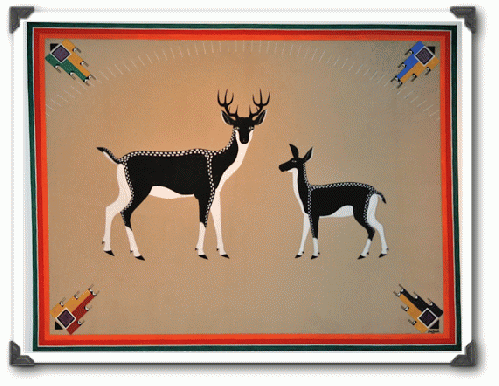
Native American art at the School for Advanced Research
(Image by Joyce Wyels, used with permission) Details DMCA
Martha White died in 1937, but her sister Elizabeth carried on until her death in 1972 as a supporter of Native American rights and patron of New Mexican traditional art forms. Among the Santa Fe institutions she helped establish are the Wheelwright Museum and the Santa Fe Animal Shelter. Her pet cemetery on the grounds of the School for Advanced Research still draws visitors to see the graves inscribed with the names of her Irish wolfhounds.
In 1989, a latter-day transplant from northern Italy, Patrizia Antonicelli, was intrigued to discover the strong, unconventional women who had left their marks on northern New Mexico. Inspired, she designed tours based on the notable women, past and present, of northern New Mexico. She didn't lack for material. Starting with the historical coterie--O'Keeffe, Luhan, the White sisters, art collector and fashionista Millicent Rogers, and the iconoclastic abstract expressionist Agnes Martin--Antonicelli developed an itinerary of the New Mexico treasured by its early enthusiasts. From O'Keeffe's many-splendored mesas to the museum collections and artful lodgings in Taos and Santa Fe, she shows visitors how New Mexico worked its transformative magic on feminine creative spirits.
"It takes courage to look within and go against the rules of your class or environment," says Antonicelli, a former gallery owner herself. "These women found alternative ways of life and started from scratch. In addition, they did it without mourning their past lives." Citing a trend toward "conscious tourism," Antonicelli adds, "That's why I call my tours 'Seven Directions.' Besides the cardinal directions, and above and below, the remaining dimension leads to the heart."
As phenomenal as the illustrious women from the East Coast, says Antonicelli, are the incomparable Native American artists and potters like Maria Martinez of San Ildefonso Pueblo (who was born in 1887, the same year as O'Keeffe) and Margaret Tafoya, born in 1904 and considered the matriarch of Santa Clara Pueblo potters. Both are collected by museums and individuals, and are renowned for their superb black pottery. Tafoya's daughter, Toni Roller, and Martinez' eldest great-granddaughter, Barbara Gonzalez, carry on the tradition and the excellence of this work in their respective pueblos.
Antonicelli says, "These women have really come a long way. Mabel Dodge Luhan still had her money; she was still in her comfort zone." But the Native American women, she points out, have used their artistic skills to innovate, creating a bridge into another world.
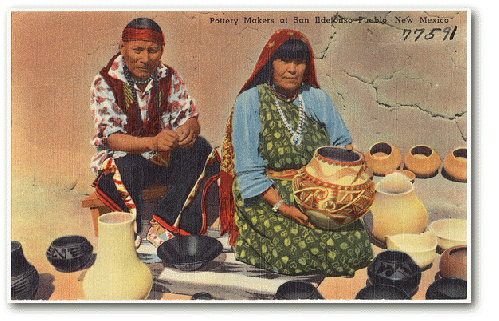
Vintage postcard of potters at Ildefonso Pueblo
(Image by (From Wikimedia) Boston Public Library, Author: Boston Public Library) Details Source DMCA
Antonicelli pays special tribute to the Native American women who courageously take on social issues like hunger and education. She singles out Roxane Swentzell, a sculptor from Santa Clara Pueblo whose works are exhibited internationally. Co-founder of the Flowering Tree Permaculture Institute, which has been saving native seeds since 1987, Swentzell is now spearheading "The Pueblo Food Experience." Its goal is to improve the health of Native Americans by restoring their traditional diets.
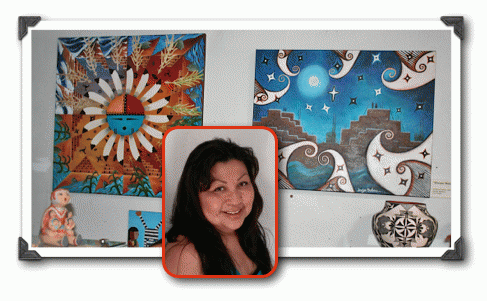
Jocelyn Martinez (inset) with her art, Taos Pueblo
(Image by Inset photo courtesy Jocelyn Martinez, artwork photo by Joyce Wyels. Both used with permission) Details DMCA
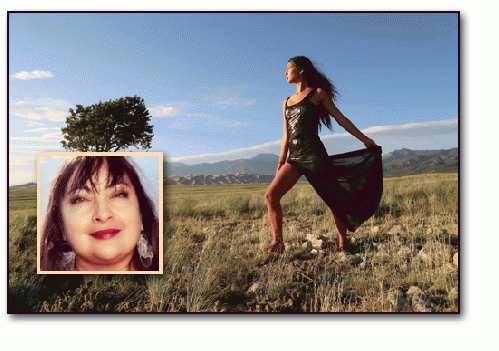
Patricia Michaels (inset) and one of her fashion designs.
(Image by Inset by Jennifer Esperanza, fashion photo by Bill Curry) Details DMCA
The influence, however, of that earlier generation of free-spirited female artists who became passionate over this picturesque land remains powerful. Santa Fe, New Mexico's capital city, honored 2007 as "The Year of Georgia O'Keeffe."
In 2016, the Harwood Museum of Art in Taos will present an exhibition based on Mabel Dodge Luhan and her celebrated circle of friends.
To visitors' delight, after several years of disuse, the D. H. Lawrence Ranch has recently been reopened to the public.
The last word on creativity and gender may belong to author Mary Hunter Austin.
Also enamored by Taos Pueblo, in 1929 she collaborated with photographer Ansel Adams to write text for a superb, limited-edition work of art.
She also wrote:
"What women have to stand on squarely is not their ability to see the world as men do, but the importance and validity of seeing it in some other way."
Please note: author Vicki Leon is taking a sabbatical from her "Uppity Women Wednesdays" feature while she works on some exciting projects. In the meantime, please enjoy the UWW archives!
Managing Editor Meryl Ann Butler edited text and photos for this article.
The Harwood Museum of Art is located in Taos, New Mexico. Founded in 1923 by the Harwood Foundation, it is the second oldest art museum in New Mexico. The "Mabel Dodge Luhan & Company: American Moderns and the West" exhibition will premiere at the Harwood Museum on May 22, 2016 and be on view through September 11, 2016. The exhibition will then travel to the Albuquerque Museum of Art and History, and will be open from October 29, 2016 through January 22, 2017. After that, the exhibit be shown in Mabel's original home in Buffalo, New York, at the Burchfield Penney Art Center.
Seven Directions Tours offers slow-paced cultural tours and excursions throughout the American Southwest with an emphasis on the culturally rich and fascinating areas of Northern New Mexico, including tours focusing on the female artists mentioned in this article.


